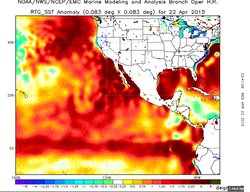Six Alaskans will be joining more than 70 scientists and resource managers this week to share observations and data about unusual ocean weather and climate patterns observed throughout 2014 and early 2015 across the North Pacific basin.
The 2014-2015 Pacific Anomalies Science and Technology Workshop is being held at the Scripps Institute of Oceanography in La Jolla, California May 5-6 and is co-sponsored by the Integrated Ocean Observing System. Molly McCammon, Executive Director of the Alaska regional component of IOOS – the Alaska Ocean Observing System or AOOS – is organizing Alaska participation in the workshop.
“Scientists across Alaska have noted some unusual ocean and atmospheric conditions this past year,” McCammon said, “even more extreme than the climate change impacts we’ve seen over the past decade.”
Some of the unusual Alaska conditions may be related to areas of the North Pacific that have been as much as 5°C warmer than average, earning the nickname ‘the blob’, and appear to be impacting pelagic ecosystems, including fisheries.
This workshop is the first of two designed to understand the timing and scale of these anomalous oceanographic conditions in the North Pacific. Global and coastal ocean observing systems can then work jointly to deliver the information needed by stakeholders such as commercial fishermen and resource agency managers to understand the potential effects of these conditions on ocean resources. The first workshop will focus on research questions to understand the scope of these ocean changes, while the second, targeted for next winter, will focus on better understanding the potential weather, resource and economic impacts from the unusual ocean conditions, and on ways to better predict their occurrences.
Some of the Alaska conditions noted in the past year include:
- Unusually warm sea temperatures were observed for 2014 across the entire Gulf of Alaska, including in Kachemak Bay, central Prince William Sound and offshore from Resurrection Bay near Seward. Temperatures were the warmest since 2005 in many locations. Warm ocean conditions could enhance zooplankton production and the salmon and herring that feed on them.
- Gulf of Alaska surface waters were generally fresher (less salty) than in prior years, which increases water column stability and could have significant impacts on the phytoplankton that form the base of the marine food web.
- Air temperatures across Alaska were significantly warmer in the past year, and some parts of Alaska experienced record low snowpack this past winter, and other parts experienced record rainfall this past year. “Numerous daily and monthly high air temperature records were set across Alaska in the past year. These conditions could affect wetland tundra habitats, river breakup, fire danger, and village water supplies. .
The May 5-6 workshop will be webcast and will be available at:

